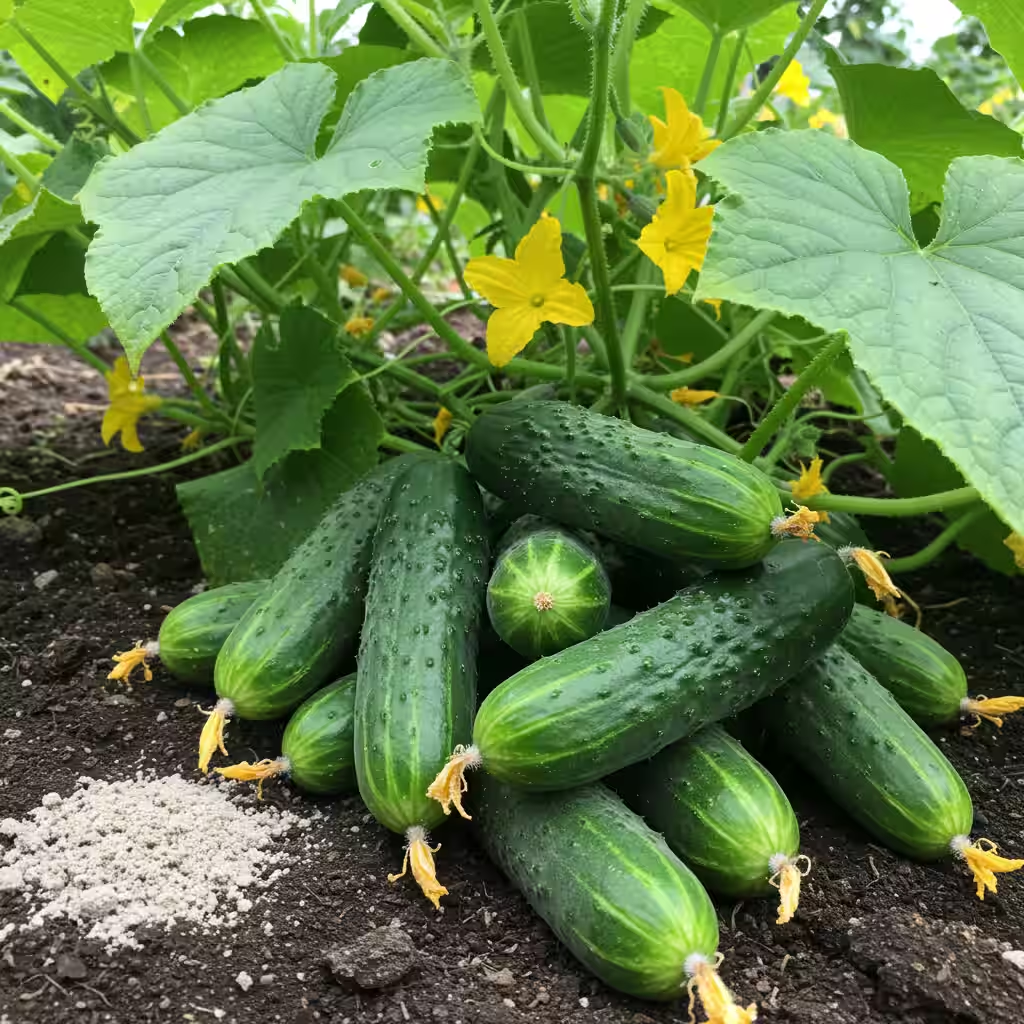For decades, experienced gardeners have been quietly using a simple kitchen ingredient to transform their cucumber harvests from ordinary to extraordinary. This natural trick costs just pennies, requires no special equipment, and delivers results that can rival or surpass expensive commercial products. If your cucumber plants have ever disappointed with bitter fruit, stunted growth, or low yields, this time-tested solution might be exactly what your garden needs.
Why Cucumbers Need Special Attention in the Garden
Cucumbers (Cucumis sativus) are among the most rewarding vegetables to grow at home. In just 50-70 days from planting, these vigorous vines can produce an abundance of crisp, refreshing fruits that taste far superior to anything available in grocery stores. But this rapid growth and prolific fruiting come with significant nutritional demands.
Unlike some more self-sufficient vegetables, cucumbers are classified as “heavy feeders,” requiring a consistent supply of essential nutrients throughout their growing season. Without proper nutrition, even the most carefully tended cucumber plants can struggle.
Common Signs of Undernourished Cucumber Plants
When cucumber plants don’t receive adequate nutrition, they display several telltale symptoms:
- Yellowing leaves, particularly on older growth
- Slow-growing or stunted vines that fail to spread
- Reduced flowering or flowers that drop without producing fruit
- Small, misshapen, or extremely bitter cucumbers
- Increased susceptibility to pests and diseases
- Early plant decline before the end of the growing season
While synthetic fertilizers can address some of these issues, many gardeners prefer sustainable, natural alternatives that support long-term soil health rather than quick fixes that may create dependency or environmental concerns.
The Surprising Power of Yeast in the Garden
The secret ingredient transforming cucumber patches across the country isn’t an expensive specialty product—it’s ordinary baker’s yeast. This humble ingredient, better known for its role in bread-making and brewing, contains powerful compounds and beneficial microorganisms that can revolutionize your garden’s productivity.
How Yeast Benefits Your Cucumber Plants
Yeast works through multiple mechanisms to enhance plant growth and fruit production:
1. Enhanced Root Development
The active components in yeast stimulate root growth and development. Stronger, more extensive root systems allow cucumber plants to:
- Access moisture from deeper soil layers during dry periods
- Absorb nutrients from a greater soil volume
- Anchor more securely, supporting heavier yields
- Establish more robust mycorrhizal relationships
2. Improved Soil Microbiology
When applied to soil, yeast introduces beneficial microorganisms that:
- Break down organic matter into plant-available nutrients
- Compete with harmful pathogens
- Improve soil structure through microbial activity
- Create healthier growing conditions for sensitive roots
3. Natural Growth Stimulation
Yeast contains natural plant growth promoters, including:
- B vitamins that support plant metabolism
- Amino acids that serve as building blocks for plant tissues
- Enzymes that catalyze important biological processes
- Naturally occurring growth hormones that enhance development
4. Strengthened Plant Defense Systems
Regular applications of yeast fertilizer help cucumber plants develop stronger natural immunity against:
- Common fungal issues like powdery mildew
- Bacterial infections
- Insect pests such as aphids and cucumber beetles
- Environmental stressors including heat and drought
Creating Your Own Yeast Fertilizer: A Simple Recipe
One of the most appealing aspects of this garden hack is its simplicity. With just three common ingredients and a few minutes of preparation, you can create a powerful natural fertilizer that costs far less than commercial alternatives.
Ingredients
- 10 grams of active dry yeast (approximately one standard packet)
- 1 tablespoon white sugar
- 5 liters (1.3 gallons) warm water
Step-by-Step Instructions
- Activate the yeast: In a small bowl, combine the dry yeast and sugar. Add about 1/2 cup of the warm water (temperature should be comfortably warm to the touch, not hot). Stir gently to dissolve.
- Allow activation: Let the yeast mixture sit undisturbed for 10-15 minutes. You’ll know it’s ready when it develops a frothy, bubbly texture on top.
- Complete the mixture: Transfer the activated yeast to a larger container and add the remaining warm water. Stir thoroughly to combine.
- Apply immediately: For best results, use this fertilizer solution while it’s still warm and active. Apply directly to the soil around your cucumber plants, avoiding direct contact with stems and leaves.
There’s no need for any additional dilution—this solution is ready to use as soon as it’s mixed.
Application Guidelines for Maximum Benefit
For optimal results, follow these application recommendations:
- When to start: Begin applications when cucumber plants have developed their first set of true leaves (not the initial seed leaves).
- Frequency: Apply every 10-14 days throughout the growing season.
- Timing: Early morning or evening applications are ideal to prevent rapid evaporation and nutrient loss.
- Method: Pour approximately 2 cups (500ml) of the solution around the base of each plant, focusing on the root zone.
- Coverage: Ensure the solution reaches the active root zone by applying in a ring around each plant, approximately 3-4 inches from the stem.
Expanding Beyond Cucumbers: Other Garden Beneficiaries
While this fertilizer solution works wonders for cucumbers, its benefits extend to many other garden favorites. Consider applying it to:
Fruiting Vegetables
- Tomatoes: Supports vigorous growth and may help prevent blossom-end rot
- Peppers: Encourages more abundant flowering and fruit set
- Eggplants: Promotes larger, more uniform fruits
- Squash and zucchini: Helps maintain production throughout the season
Vining Crops
- Melons: Enhances sweetness and size of fruits
- Pumpkins: Supports development of larger, healthier fruits
- Watermelons: Improves vigor and disease resistance
Other Garden Plants
- Roses: Promotes more abundant blooming
- Flowering annuals: Enhances vigor and bloom count
- Container plants: Provides gentle nutrition without chemical buildup
Comprehensive Cucumber Care: Beyond Fertilization
While proper nutrition forms the foundation of successful cucumber growing, several other factors contribute to a truly abundant harvest.
Sunlight Requirements
Cucumbers thrive in full sun conditions, requiring:
- At least 6-8 hours of direct sunlight daily
- Protection from intense afternoon sun in very hot climates
- Adequate spacing to prevent plants from shading one another
Water Management
Consistent moisture is crucial for cucumber success:
- Maintain even soil moisture, especially during flowering and fruiting
- Apply water directly to soil rather than overhead to prevent fungal issues
- Consider drip irrigation or soaker hoses for precise delivery
- Add mulch to conserve moisture and regulate soil temperature
Support Systems
While bush varieties can grow without support, most cucumber plants benefit from vertical growing:
- Trellises, cages, or A-frames keep fruits clean and straight
- Vertical growing maximizes garden space and improves air circulation
- Supported plants are easier to harvest and monitor for pests
- Fruits developing off the ground have fewer issues with rot or insect damage
Companion Planting Strategies
Certain plants benefit cucumbers when grown nearby:
- Marigolds: Repel nematodes and other soil pests
- Nasturtiums: Draw aphids away from cucumber plants
- Dill and fennel: Attract beneficial predatory insects
- Radishes: Deter cucumber beetles when planted as a border
Harvesting for Continued Production
How you harvest significantly impacts overall yield:
- Pick cucumbers frequently to encourage continued production
- Harvest in the morning when fruits are most crisp
- Use sharp scissors or pruners rather than pulling to avoid damaging vines
- Remove overripe cucumbers immediately, as they signal the plant to slow production
Troubleshooting Common Cucumber Challenges
Even with excellent care, cucumber plants sometimes encounter problems. Here’s how to address common issues:
Bitter Fruits
Bitterness in cucumbers typically results from:
- Environmental stress: Inconsistent watering or extreme temperatures
- Genetic factors: Some varieties naturally contain more cucurbitacins (bitter compounds)
- Overmaturity: Cucumbers left too long on the vine develop bitterness
Solution: Harvest regularly, maintain consistent moisture, and select low-bitterness varieties. The yeast fertilizer helps reduce bitterness by minimizing plant stress.
Pest Management
Common cucumber pests include:
- Cucumber beetles: Yellow and black striped or spotted beetles that spread bacterial wilt
- Aphids: Tiny sap-sucking insects that cluster on new growth
- Spider mites: Microscopic pests that cause stippling on leaves, especially during hot, dry weather
Solution: Regular applications of yeast fertilizer strengthen plants’ natural defenses. For active infestations, consider neem oil, insecticidal soap, or introducing beneficial predators.
Disease Prevention
Cucumbers may suffer from several diseases:
- Powdery mildew: White powdery coating on leaves
- Downy mildew: Yellow spots on leaf surfaces with gray fuzz underneath
- Bacterial wilt: Sudden wilting of vines after cucumber beetle feeding
Solution: The improved soil biology from yeast applications helps prevent many diseases. Additionally, ensure proper spacing, morning watering, and prompt removal of affected plant material.
Why This Natural Method Outperforms Commercial Products
Gardeners who switch to yeast-based fertilization often report several advantages over commercial products:
Economic Benefits
- Cost-effective: A season’s worth of yeast fertilizer costs less than a single bottle of commercial liquid fertilizer
- Readily available: Uses ingredients most households already have on hand
- No special storage: Unlike many garden chemicals, requires no special storage considerations
Environmental Advantages
- Eco-friendly: Creates no harmful runoff that might affect waterways
- Soil-building: Enhances soil health rather than depleting it over time
- Biodiversity support: Encourages beneficial soil organisms that support the entire garden ecosystem
Long-term Garden Improvements
- Cumulative benefits: Soil improves season after season with regular use
- Reduced dependency: Plants develop natural resilience rather than requiring increasing chemical inputs
- Sustainable practice: Aligns with organic and regenerative gardening philosophies
Conclusion: A Time-Tested Solution for Today’s Gardens
In an era of expensive specialty products and complex garden solutions, this 50-year-old technique stands out for its simplicity, affordability, and effectiveness. By harnessing the natural power of yeast, you’re not just feeding your cucumber plants—you’re supporting the entire soil ecosystem that forms the foundation of garden success.
Whether you’re a novice gardener hoping to avoid common cucumber disappointments or an experienced grower looking to maximize production naturally, this yeast fertilizer deserves a place in your garden routine. With minimal investment and just minutes of preparation, you can put this garden wisdom to work and enjoy the crisp, abundant cucumber harvest you’ve always wanted.
As generations of successful gardeners can attest, sometimes the most effective solutions are also the simplest. Try this natural fertilizer approach this season and discover why so many gardeners consider it their secret weapon for extraordinary cucumber harvests.

